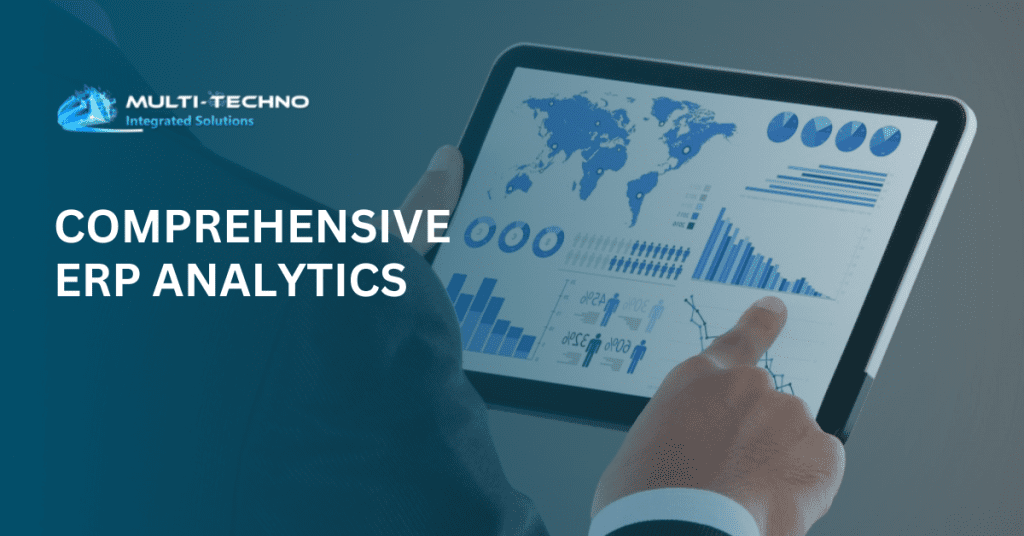Multi-Techno Integrated Solution

Table of Contents
ToggleNavigating Through Comprehensive ERP Analytics
ERP analytics software/solutions involves using ERP programs and other services to collect and analyze the data generated by organizations’ activities, with dashboards, reports, and visualizations of graphs, maps, and charts used to present performance indicator patterns, trends, and predictions to users so that sound business decisions may be made faster and easier. It helps users gain insights by making it simpler to combine search query information, enabling sound business decision-making practices.
Compare Top ERP Software Leaders
As an example, manufacturing firms needing to manage their supply chain can use ERP analytics to detect differences in shipping processes that may cause delays and then determine the most efficient routes that avoid them. Furthermore, sales teams could consolidate sales data using ERP Solutions in order to create an online dashboard which displays region sales figures such as typical weekly revenue, customer acquisition profits and more.
Users utilize ERP analytical capabilities to conduct transformation, develop efficient processes, eliminate redundant tasks, and respond to changing market circumstances.ERP analytics refers to a set of techniques and processes designed to gather, analyze, and store business-related data in order to improve efficiencies. ERP analytics gives individuals involved in the business an in-depth picture of the organization so that decisions made are based on facts rather than intuition alone.
Reporting: Working collaboratively with stakeholder groups to provide reports containing data analysis results so that they may make more informed choices. Reports contain graphs and charts to display conclusions drawn from a single source.
Measures of Performance: Compare current performance data with data from the past to assess how your goals have been achieved using custom dashboards.
Descriptive analytics: Descriptive Analytics is a form of statistical analysis which summaries historical data to reveal patterns and trends.
Data Queries: To quickly obtain specific answers or obtain information from large datasets.
Stats Analyses: Generate results through descriptive analysis, then conduct additional examination of your data using inferential statistics to uncover any underlying trends or causes for them.
Data Visualization: Produce visual representations of data such as graphs, charts maps histograms and maps to quickly convey vital information.
Visual Analysis: Visual storytelling offers another means of exploring data quickly for insight on-the-spot.
Preparing Data: Data preparation requires gathering information from different sources, filtering out discrepancies, identifying measurements and dimensions, and making the information ready for analysis. Get our ERP Software Requirements Template now to make this task easy!
Let's consider some of the primary advantages of ERP analytics.
Forecasting Demand involves finding patterns and trends in historical data that indicate fluctuations in sales over time. Users can then utilize this information to help businesses determine when it would be most prudent to stock up on items that will become in-demand inventory – the program then analyzes these factors to provide businesses with appropriate guidance on this front.
Influencers with many followers could use Instagram posts about products to boost sales. While ERP analytics are most often associated with retail, its applications also extend into customer service and manufacturing operations – for instance when there’s an unexpected rise in demand for items with difficult-to-get components that necessitate expanding supplier chains or searching for alternative sources of supply chains to fulfill it.
Supervisors in beverage factories who oversee production schedules may find it beneficial to approve shifts so production matches demand, should sales graphs indicate rapid monthly increases for specific regions.
ERP analytics gathers and analyses consumer data in order to help them better understand their preferences, aiding decision making and providing valuable information about consumer behaviors such as what items they purchase frequently as well as their perspectives on sales, marketing and service provision.
Consumer Data Analytics refers to the analysis of customer behavior using ERP system data as its source. Its primary objectives include attracting and keeping profitable customers.
Consumer analytics encompasses:
Personas of customers provide a clear image of customers to assist companies in making sound decisions regarding customer acquisition and retention.Deliberately engaging these segments regularly to gain more understanding about their preferences.As your knowledge of customers grows, so will your ability to use predictive analytics accurately predict their behavior.
ERP Analytics Offer Real-Time Insights
ERP analytics gives real-time insight into customer data. It can analyze customer behavior and develop strategies to increase levels of satisfaction with products or services offered to customers. Real-time analytics increase profits while simultaneously decreasing costs allowing businesses to achieve exponential growth.
Anticipating market movements, identifying opportunities, and helping managers make sound decisions is made easier with fast solutions and remedies available for immediate implementation. Companies can predict accurately while improving data to gain competitive advantages for business success.
Predictive Analytics Fuel Growth
Predictive analytics allows businesses to develop strategies based on data to address issues and maximize opportunities for growth in their business. Being aware of all of the changes affecting stakeholders, customers, vendors and departments helps understand how any shifts impact them all – it removes guesswork from decision making process while using data for hard decisions making.
Compare Leading ERP Software Solutions Providers
KPIs (key performance indicators) are quantitative measures used to gauge overall company performance. KPIs focus on strategic, financial and operational results that compare against their competition; as well as tracking progress towards meeting specific goals or targets within an expected timeline. KPI management encompasses creating, executing, monitoring and analyzing KPIs that assist businesses in accomplishing their goals more easily.Before beginning an ERP implementation strategy, it’s crucial that you understand how you’ll measure its performance. KPIs play a pivotal role here; evaluate these KPIs both before and after ERP implementation for proper evaluation of performance. Below are a few key KPIs to
Keep in mind during an ERP implementation:
One of the primary goals of investing in an ERP system for businesses is to enhance collaboration among both existing and potential customers, and enhance customer service. ERP solutions streamline business processes while simultaneously improving processes related to customer care – for example if you run an online store where orders need to be fulfilled promptly using shipping details in a central database, an ERP solution can help manage orders in real-time and improve delivery time; improving their experience along the way.
Consistency is also vital when providing exceptional customer service. If a company consistently provides an enjoyable experience to its customers, they’re likely to return and purchase. One way of measuring customer satisfaction levels is through online reviews, surveys or listening and responding to complaints from customers.
Increased Inventory Turnover refers to the amount of inventory sold over a given timeframe. ERP solutions can increase inventory turnover by providing greater visibility into inventory levels and processes for managing supply chains.
Consider, for instance, you have an excess stock of one product. An ERP solution could use predictive analytics to calculate how many need to be stored away for future use and predict consumer behavior in order to stock products effectively, reduce waste and trim expenses.
Implementation of ERP software will likely result in increased revenue as it enhances business processes and increases efficiency, cutting expenses through enhanced processes while giving you live information to make smarter choices to reduce costs and increase sales.
Companies use software to enable real-time data access for informed decision-making by using dashboards and reporting capabilities. While each system’s business intelligence features may differ in complexity, all can provide users with insights that enhance understanding of data.
ERP systems with advanced business intelligence capabilities inform workers at factories of which machines require maintenance, enabling users to conduct advanced planning, reduce downtime and set realistic expectations.
Increase Your Buying Power
ERP solutions can increase buying power by finding the most appropriate suppliers. They utilize supplier Performance Management capabilities to detect weaknesses and negotiate better terms with them in order to find those which offer superior products or services.ERP analytics enable them to assess suppliers and identify those costing more than expected. Expensive suppliers are replaced with less costly suppliers providing similar raw materials – helping lower material costs while increasing productivity.
ERP Analytics Tools:
Explore the power of ERP analytics tools, essential for collecting and analyzing organizational data. Enhance decision-making processes with dashboards, reports, and visualizations.
Business Intelligence in ERP:
Discover the synergy of business intelligence within ERP systems, leveraging data-driven insights to streamline processes, enhance collaboration, and make informed strategic decisions.
Predictive Analytics in Business:
Unleash the potential of predictive analytics in business. Anticipate trends, identify opportunities, and make data-driven decisions for sustainable growth and competitive advantage.
Real-time Insights with ERP:
Experience the benefits of real-time insights through ERP systems. Make informed decisions swiftly, anticipate market movements, and stay ahead of the competition with immediate access to critical data.
KPI Management in Organizations:
Efficiently manage Key Performance Indicators (KPIs) in organizations. Track and analyze strategic, financial, and operational results to measure progress and achieve business goals.
Customer Satisfaction Metrics:
Delve into customer satisfaction metrics using ERP systems. Understand consumer preferences, enhance decision-making, and build strategies for attracting and retaining profitable customers.
Inventory Turnover in ERP:
Optimize inventory turnover with ERP solutions. Gain visibility into inventory levels, predict consumer behavior, and improve supply chain processes to reduce waste and expenses.
Supplier Performance Management:
Enhance supplier relationships through ERP analytics. Identify weaknesses, negotiate better terms, and improve buying power by effectively managing supplier performance.
ERP System Advantages:
Unlock the advantages of ERP systems in business. Increase efficiency, cut expenses, and gain real-time information for smarter decision-making, ultimately boosting revenue.
Data Visualization Techniques:
Master data visualization techniques within ERP. Create impactful dashboards, reports, and visual representations, enabling users to gain valuable insights for improved business understanding.
Conclusion ERP analytics
can be an excellent way to gain competitive edge and gain vital business insight. Utilizing this software, data from various sources can be collected to create dashboards and reports tailored specifically for specific business units or departments. Users can access pre-packaged analytics or connect other BI tools for advanced analysis capabilities.
Best cloud ERP software solution

About Us
ERP software and systems are designed and implemented by Multi-Techno, a registered company. By combining data from financials, sales, CRM, inventories, and operations, businesses can increase productivity, make better decisions, and increase profitability with the aid of our ERP System, a single, integrated software platform.
Quick Links
Contact Us
Office # 100, 101 Second Floor Kohinoor 1, Faisalabad, Pakistan
